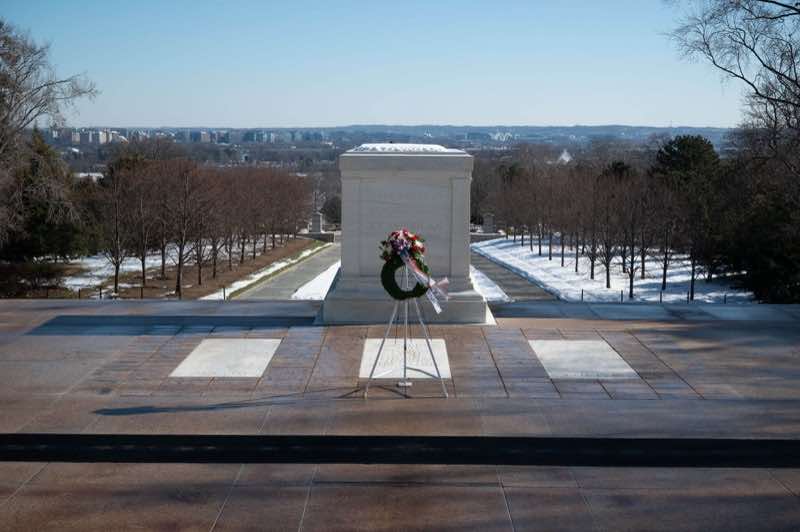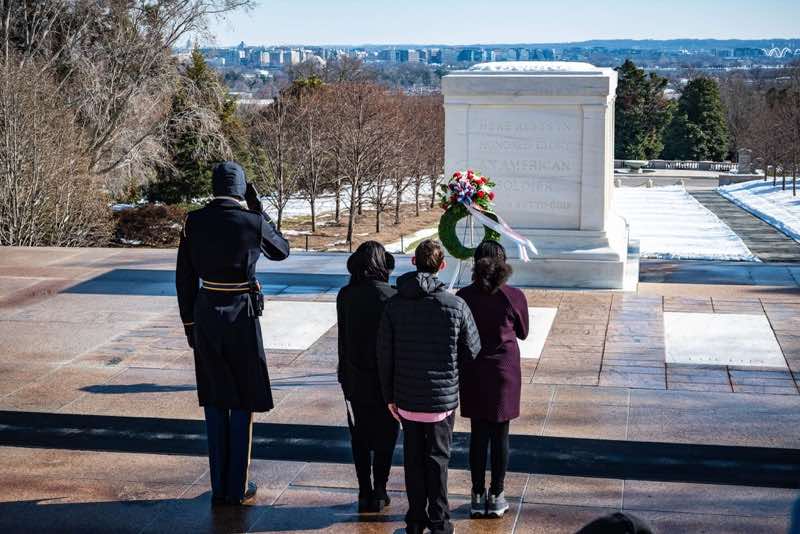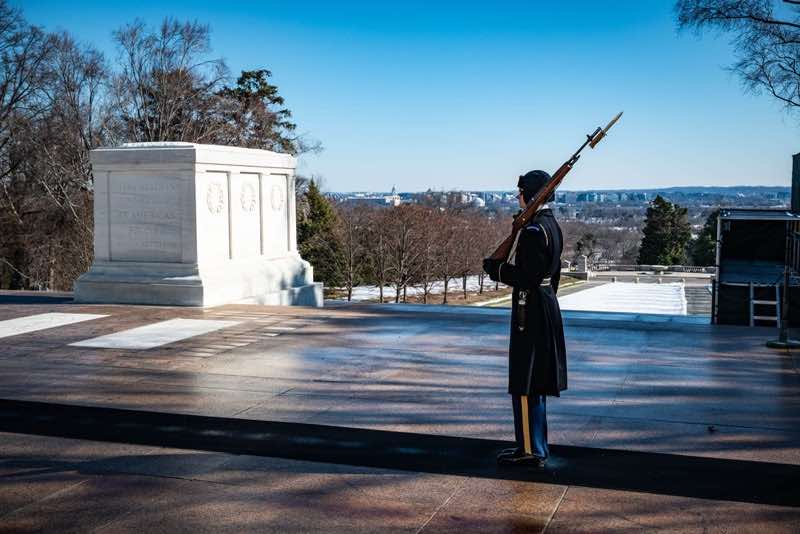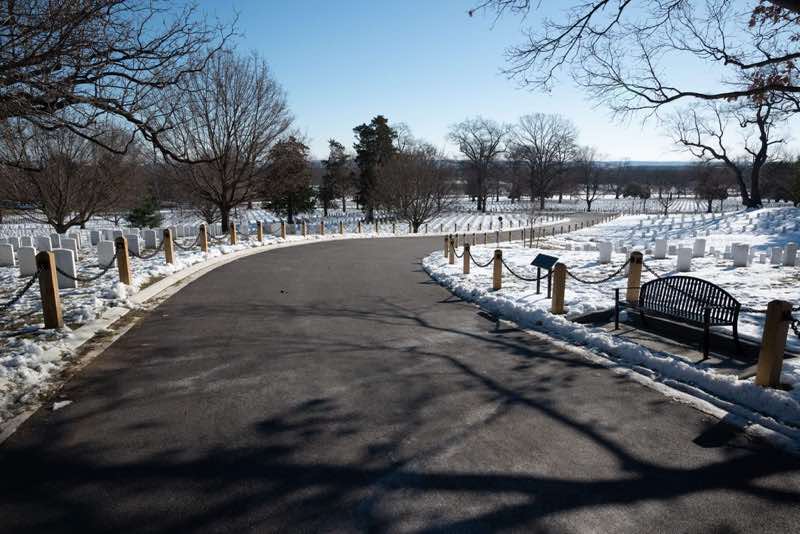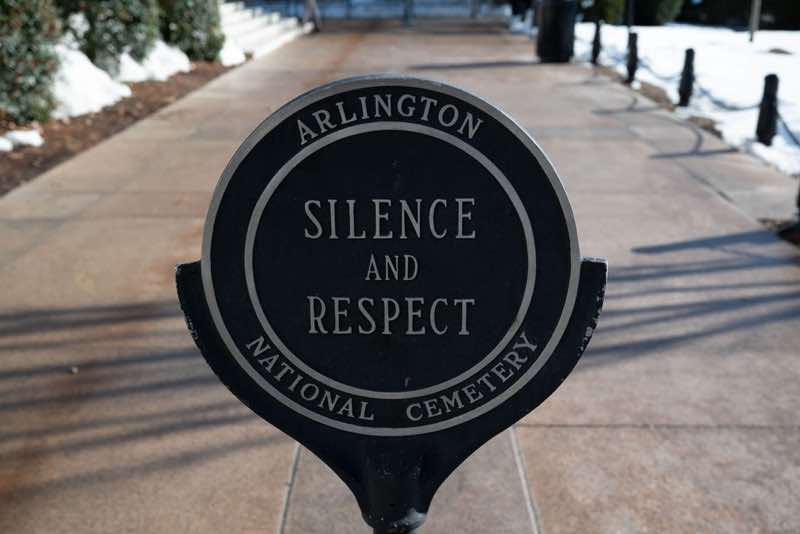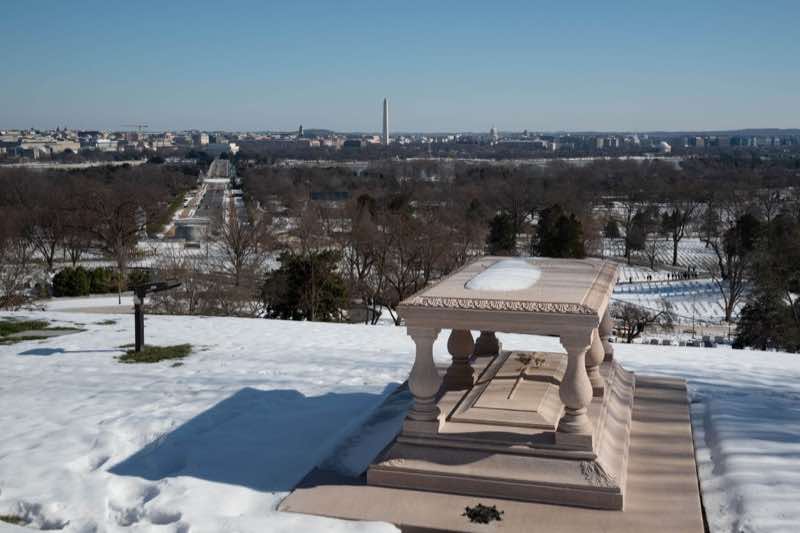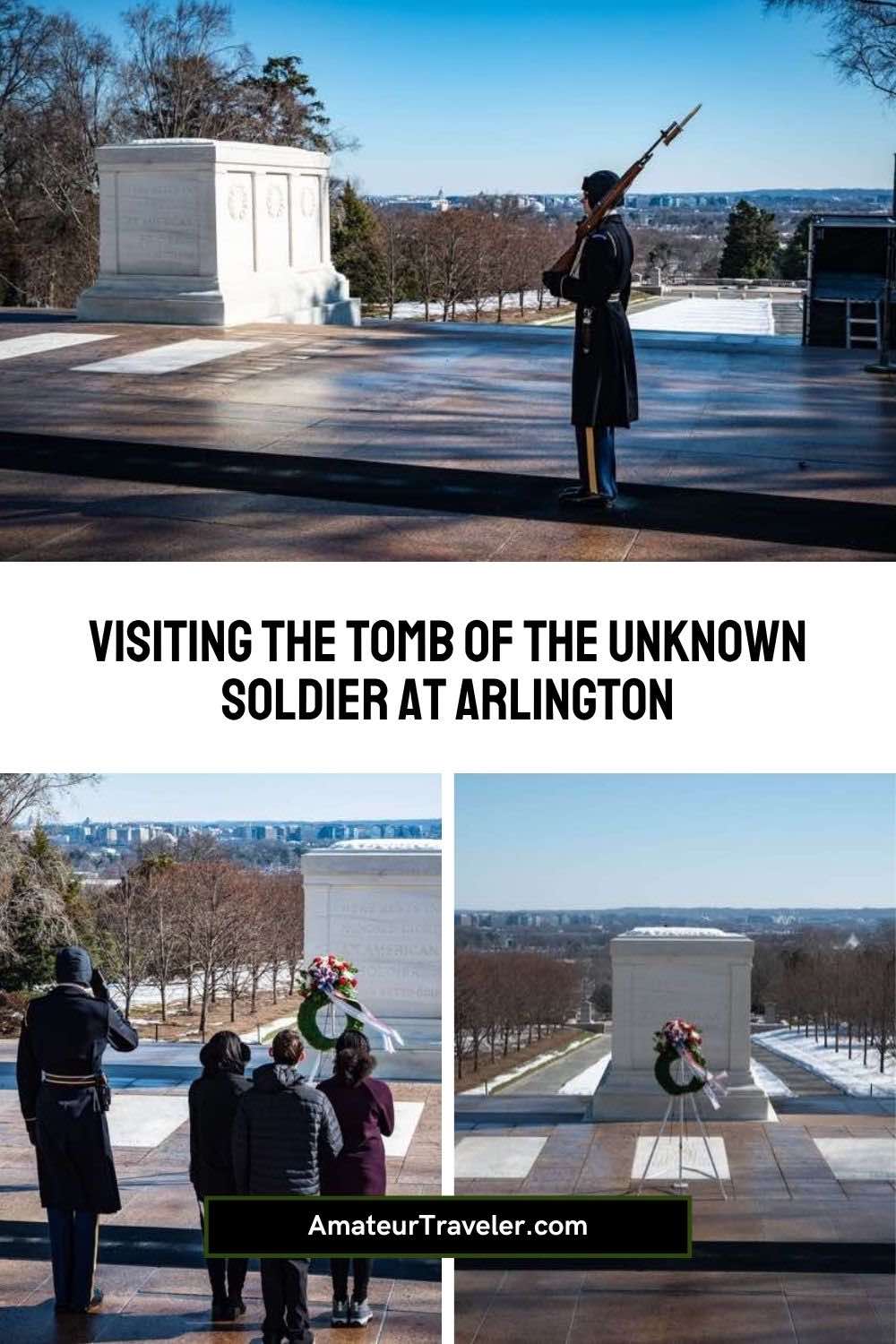The Tomb of the Unknown Soldier at Arlington National Cemetery is much more than simply a memorial. It’s a place where memory truly takes physical form. During my inspiring year living in Washington, D.C., I visited Arlington several times. Still, one cold morning in January 2025 changed the way I understood the site and the sacrifices it honors.
As snow blanketed the rows of white headstones and sunlight broke over the Potomac, a hush fell over the crowd at the Memorial Amphitheater. Children laid a green wreath before the Tomb, guided by a sentinel in uniform. Cameras clicked softly, and the crowd stood perfectly still. Right in that moment, I felt I was not simply witnessing a ceremony, but participating in a national act of remembrance.
That visit helped me see how ritual, place, and memory converge at Arlington. This post shares what I learned – from the symbolism of the Tomb itself to the story of its sentinels, and why it’s one of the most powerful places to visit in Washington, D.C.
Who Lies at the Tomb of the Unknown Soldier?
As of today, there are three people buried at the Tomb of the Unknown Soldier:
- World War I Unknown – Interred in 1921
- World War II Unknown – Interred in 1958
- Korean War Unknown – Interred in 1958
The first interment took place in 1921, honoring an unidentified American soldier from World War I. Later, unknown soldiers from World War II and the Korean War were added. A Vietnam War unknown was also interred in 1984, but was exhumed in 1998 after DNA testing identified him as 1st Lt. Michael Blassie. That crypt now stands empty with its plaque honoring all missing service members from that conflict.
The Unknowns represent those who gave everything, including their names. Their identities may be lost, but the nation’s gratitude endures to this day.
The Origins of the Tomb
The whole idea for the Tomb of the Unknown Soldier emerged after World War I. This was a war that left countless soldiers unidentified in the chaos of trench warfare. Many grieving families had no body to bury, nor even a grave to visit. The Tomb became a symbolic resting place – not just for one man, but for all those who never made it home.
On November 11, 1921 (Armistice Day), an unidentified American soldier, selected from a battlefield cemetery in France, was laid to rest at Arlington National Cemetery. President Warren G. Harding presided over the funeral. The unknown soldier was awarded the Medal of Honor and the Victoria Cross, among others, and was buried in a white marble sarcophagus on a hill overlooking Washington, D.C.
The Tomb quickly became a place of national mourning and reverence.
In 1937, the U.S. Army began posting a sentinel to stand guard 24/7. This act of constant vigilance signaled that even in death, and even in anonymity, the service and sacrifice of this soldier would never be forgotten.
What started as a single grave has become a national site of reflection. Timeless in meaning and universal in its message: no one who serves is ever truly forgotten.
The Changing of the Guard: Precision, Symbolism, and Silence
One of the most striking aspects of visiting the Tomb is witnessing the changing of the guard. The ritual is carried out with impressive precision. Additionally, the ritual has taken place without pause since 1937, 24 hours a day, in all weather.
Only a small number of soldiers from the U.S. Army’s 3rd Infantry Regiment, known as “The Old Guard,” earn the right to perform this role. Fewer than 20% of applicants are accepted, and even fewer pass the rigorous training process to qualify. Their appearance is immaculate. Always wearing deep navy trousers with a gold stripe, spotless shoes, crisp uniforms free of a single wrinkle.
But don’t mistake the ceremonial for the performative. These soldiers are not here to impress – they are here to guard. If you speak too loudly, step out of line, or show disrespect, you’ll be swiftly and publicly corrected. And rightly so.
What struck me most was the contrast between the strict choreography of the guards and the quiet vulnerability of the children laying the wreath. The ingredients of discipline and tenderness left a deep impression on me.
It made me realise how much these American soldiers value freedom, democracy, and their duty of service.
Because of this reason alone, visiting the Tomb of the Unknown Soldier at Arlington National Cemetery is one of the best things to do in Washington DC.
Video of the Tomb of the Unknown Soldier
Behind the Scenes: Life as a Tomb Guard
While witnessing the changing of the guard is certainly a worthwhile experience, discovering what it takes to become a sentinel is another story.
Everything is done with precision. White gloves are only allowed to inspect the uniforms. Shoes are polished to a mirror shine. Medals and buckles on the sentinel’s belt must all be in sync. Hair has to be cut to regulation length, and each sentinel must develop the skill to move in a 21-step sequence – this symbolizes the 21-gun salute, the highest military honor.
Interestingly, when guards are off duty, they must still follow strict guidelines. They even recite a creed that includes the phrase “walk my tour in humble reverence.” Whether facing heavy humidity, hail, rain, or snow, they must remain on guard.
Could you imagine yourself performing such a duty?
Knowing all this changed how I viewed the ceremony. It’s not just tradition. It’s a living, breathing ritual – one upheld by people who’ve trained for so long to make sure we never forget the names we’ll never know.
Layers of History Beneath Your Feet
The land beneath Arlington National Cemetery carries a weighty history. I spoke with a guide inside Arlington House, the former home of Confederate General Robert E. Lee. Before the Civil War, Lee lived here with his wife, Mary Custis Lee, a descendant of Martha Washington. When Lee left the Union Army to join the Confederacy, Union forces seized the estate due to its strategic location overlooking Washington, D.C.
In 1864, the U.S. government began burying Union war dead on the property. Not only as a practical solution to overcrowded cemeteries but as a pointed message: Lee would never return home.
Today, Arlington House still stands, preserved as a memorial and museum. Its front porch offers sweeping views across the Potomac to the Lincoln Memorial and the U.S. Capitol. Standing there, I felt the pull of history in every direction.
Famous Funerals and Burials at Arlington
Beyond the history of Arlington Cemetery, the burial grounds hold many famous figures from the past who add additional layers of meaning to the site.
Some of the most famous people buried in here include John F. Kennedy and First Lady Jacqueline Kennedy, along with Robert and Edward (Ted) Kennedy. The cemetery is also the final resting place for distinguished military personnel such as Audie Murphy, America’s most decorated WWII soldier; General John J. Pershing, Commander of American forces in WWI; and General Alexander Haig, U.S. Army general and former Secretary of State.
However, what affected me most deeply was contemplating the thousands of lesser-known individuals who sacrificed everything for their country. Walking among the endless rows of headstones, I was struck by the sheer volume of sacrifice. Each marker represents not just a life, but a family forever changed.
You will also find Supreme Court justices, astronauts, and even poets and musicians who served their country. Additionally, you can see family members who earned the right to be buried with their partners.
Each grave, whether marked by a simple white cross or an elaborate monument, tells a story of sacrifice, whether known to history or quietly remembered by family and friends.
As I walked past the graves, my feet lightly squeaking in the snow, I realised how vast and deep the service members did their part – whether on the battlefield or in other ways.
Why People Visit Arlington and Why It Moved Me
Most visitors come to Arlington to reflect, to honor the fallen, or to witness the changing of the guard. Others come to see the grave of President John F. Kennedy, or to pay respects at memorials to the Challenger and Columbia shuttle crews, the Battle of the Bulge, or the victims of Pan Am Flight 103.
I visited for all those reasons, but also because I’d seen Arlington so many times on screen. Movies like Clear and Present Danger and JFK make it look pristine and abstract. But standing there in person, with the marble’s hue shifting from bright white to a darker gray, I felt something movies can’t deliver: weight. Silence. Scale. Reality.
I have friends whose loved ones are buried there. That personal connection hit me hard. The rows of identical white markers stretch across gentle hills, a visual reminder of sacrifice repeated again and again. It’s beautiful, but also deeply sobering.
The cemetery is still active today, with up to 30 funerals taking place each weekday. Additional services are also conducted on weekends. Arlington is the final resting place for more than 400,000 deceased service members, veterans, and their eligible family members.
A Personal Reflection on Memory and Service
With every visit to Arlington Cemetery, I find myself meditating on how fragile life can be rather than the monuments or history.
The cemetery holds many brothers, sisters, fathers, and mothers who never made it home alive to their loved ones. That alone is sobering.
Moreover, I have visited Arlington Cemetery during every season, experiencing both extreme heat and cold. Yet, these sentinels standing guard remain proud, disciplined, and consistent in their duties. I couldn’t help but respect them for their dedication and service.
I can’t help but think about them from time to time. Whether I see a movie, a book, or an image relating to the US Capitol or a World War conflict. Their focused movements remind me that in today’s fast-paced world, we must intentionally create time for remembrance, honoring the past to create a brighter future.
If You Go: Planning Your Visit
Getting There
- Take the Metro Blue Line to Arlington Cemetery station
- The Welcome Center is a short walk from the station
- From there, it’s a 20-minute walk to the Tomb
- Shuttle carts are available for those with mobility concerns or during hot months
Tomb Location
Changing of the Guard
- Every 30 minutes from April 1 – September 30
- Every hour from October 1 – March 31
- 24/7, 365 days a year—regardless of weather
Admission
- Free and open daily from 8:00 AM – 5:00 PM
Other Key Memorials Inside
- JFK Gravesite
- Robert F. Kennedy Gravesite
- Arlington House
- Women in Military Service for America Memorial
- Challenger and Columbia Space Shuttle Memorials
- Spanish–American War and Battle of the Bulge Memorials
Size and Scope
- Arlington National Cemetery contains over 400,000 burial sites, making it the largest in the U.S. National Cemetery System.
Final Reflections: Why It Matters
Some places you visit, take a few photos, and forget the next day. Arlington isn’t one of them.
This is a place that asks you to be quiet. To think. To acknowledge a debt you can’t repay. As I stood watching the guard remain perfectly still after the crowd had dispersed, I felt a strange mix of gratitude and guilt. Gratitude for their service. Guilt for not thinking about it more often.
For anyone visiting Washington, D.C., I can’t recommend Arlington National Cemetery strongly enough. Go to witness the ceremony, yes – but stay for what it makes you feel. Memory lives here. Honor lives here. And for a few still moments, it asks something of you, too.
You could easily spend three days in Washington, DC, to see all the main attractions and memorials.



